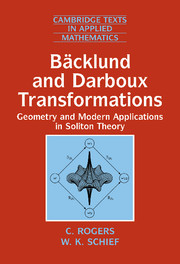Book contents
- Frontmatter
- Contents
- Preface
- Acknowledgements
- General Introduction and Outline
- 1 Pseudospherical Surfaces and the Classical Bäcklund Transformation. The Bianchi System
- 2 The Motion of Curves and Surfaces. Soliton Connections
- 3 Tzitzeica Surfaces. Conjugate Nets and the Toda Lattice Scheme
- 4 Hasimoto Surfaces and the Nonlinear Schrödinger Equation. Geometry and Associated Soliton Equations
- 5 Isothermic Surfaces. The Calapso and Zoomeron Equations
- 6 General Aspects of Soliton Surfaces. Role of Gauge and Reciprocal Transformations
- 7 Bäcklund Transformation and Darboux Matrix Connections
- 8 Bianchi and Ernst Systems. Bäcklund Transformations and Permutability Theorems
- 9 Projective-Minimal and Isothermal-Asymptotic Surfaces
- Appendix A The su(2)–so(3) Isomorphism
- Appendix B CC-Ideals
- Appendix C Biographies
- Bibliography and Author Index
- Subject Index
8 - Bianchi and Ernst Systems. Bäcklund Transformations and Permutability Theorems
Published online by Cambridge University Press: 04 March 2010
- Frontmatter
- Contents
- Preface
- Acknowledgements
- General Introduction and Outline
- 1 Pseudospherical Surfaces and the Classical Bäcklund Transformation. The Bianchi System
- 2 The Motion of Curves and Surfaces. Soliton Connections
- 3 Tzitzeica Surfaces. Conjugate Nets and the Toda Lattice Scheme
- 4 Hasimoto Surfaces and the Nonlinear Schrödinger Equation. Geometry and Associated Soliton Equations
- 5 Isothermic Surfaces. The Calapso and Zoomeron Equations
- 6 General Aspects of Soliton Surfaces. Role of Gauge and Reciprocal Transformations
- 7 Bäcklund Transformation and Darboux Matrix Connections
- 8 Bianchi and Ernst Systems. Bäcklund Transformations and Permutability Theorems
- 9 Projective-Minimal and Isothermal-Asymptotic Surfaces
- Appendix A The su(2)–so(3) Isomorphism
- Appendix B CC-Ideals
- Appendix C Biographies
- Bibliography and Author Index
- Subject Index
Summary
This chapter is concerned with the construction of Bäcklund-Darboux transformations for the generation of exact solutions to Einstein's equations for axially symmetric gravitational fields. That important connections exist between soliton theory and certain areas of general relativity was first established around 1978. Thus, in that year, Maison constructed a Lax pair for the stationary, axially symmetric Einstein equations while Belinsky and Zakharov applied the inverse scattering method to isolate simple soliton-type solutions of these reduced gravitation equations. In the same year, Harrison derived a Bäcklund transformation for the Ernst equation of general relativity by using the Wahlquist-Estabrook procedure. In 1979, Neugebauer independently established a Bäcklund transformation for Ernst's equation. This allowed the iterative generation of multi-parameter solutions from a starting ‘seed’ solution. There has since been extensive research on the application of Bäcklund transformations in general relativity. In particular, Cosgrove established important connections between group-theoretic and soliton-theoretic methods for generating not only well-known, but also new stationary axially symmetric solutions of Einstein's equations.
Here, a remarkable analogy is described between the Bianchi system of classical differential geometry as discussed in Chapter 1 and the Ernst equation of general relativity. Moreover, the Harrison transformation is shown to be an ‘elliptic’ equivalent of the classical Bäcklund transformation for Bianchi surfaces as derived as long ago as 1890. The Neugebauer transformations emerge as the basic building blocks for the known auto-Bäcklund transformations for the Ernst equation.
- Type
- Chapter
- Information
- Bäcklund and Darboux TransformationsGeometry and Modern Applications in Soliton Theory, pp. 297 - 328Publisher: Cambridge University PressPrint publication year: 2002



